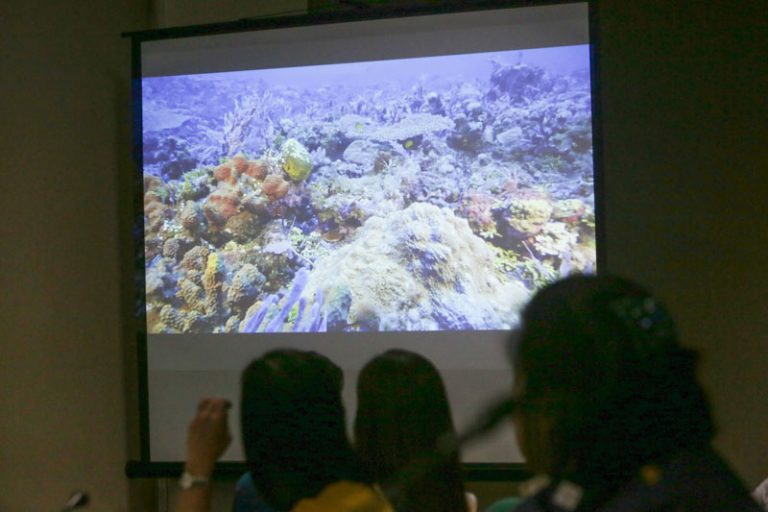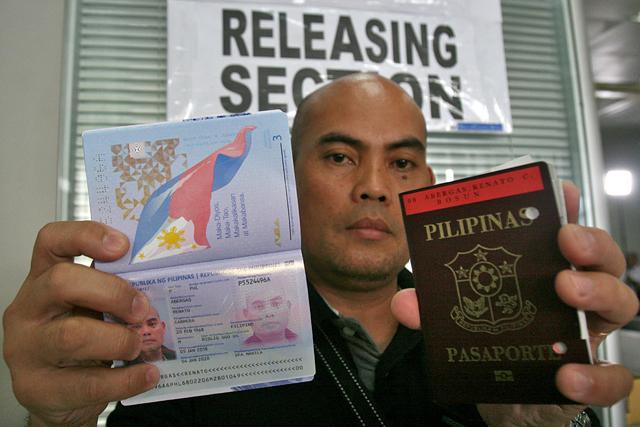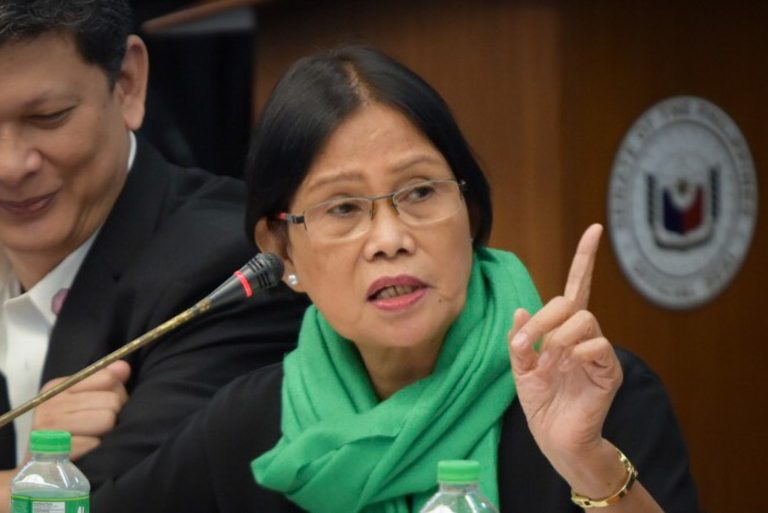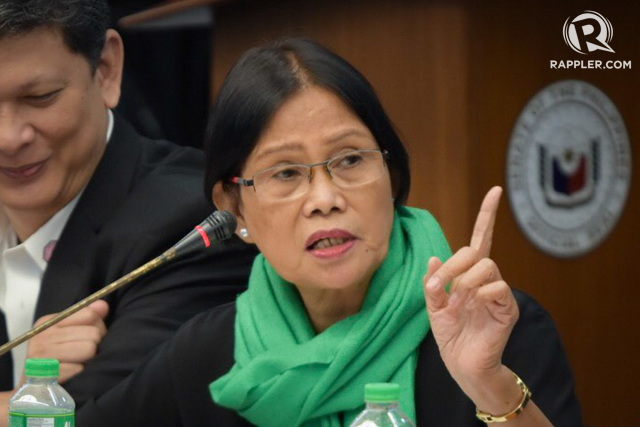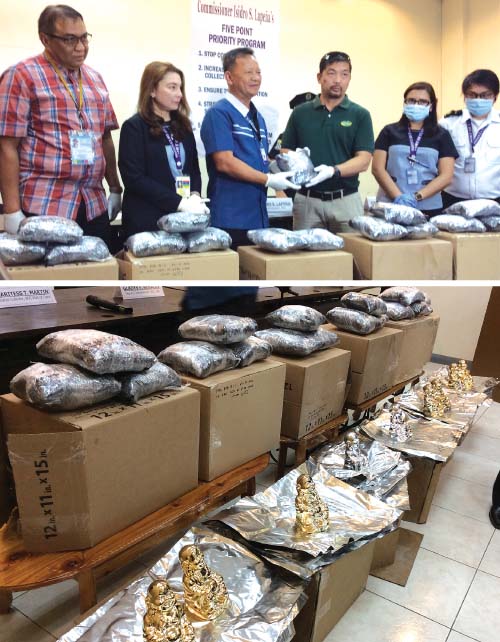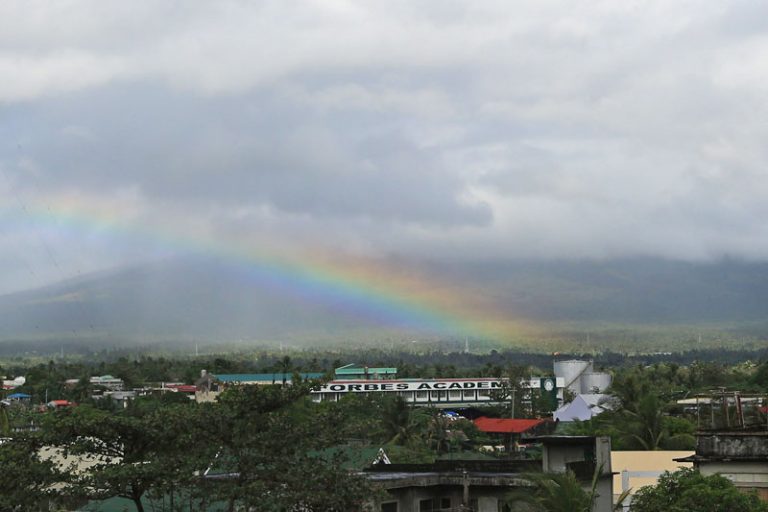Happy anniversary to Primo Arellano’s lovely parents! Read their messages for each other.
READ: Drew Arellano and Iya Villania’s kilig fourth anniversary messages
WATCH: Celebrities, emosyonal sa burol ni Direk Maryo J. Delos Reyes
Nagtipon-tipon kagabi (January 30) ang mga kaanak, kaibigan at mga katrabaho ng award-winning director na si Direk Maryo J. Delos Reyes sa kanyang burol sa Loyola Memorial Chapels sa Quezon City.
‘Probe Benham Rise research deal’
MANILA, Philippines — Seven leftist party-list lawmakers belonging to the Makabayan bloc want the House of Representatives to look into the government-approved Chinese maritime research in Benham Rise.
The seven, led by Bayan Muna Rep. Carlos Zarate, suggested that the House committee on foreign affairs conduct the inquiry.
In Resolution No 1623, Zarate and his colleagues said the United Nations Commission on the Limits of the Continental Shelf awarded Benham Rise, renamed Philippine Rise, to the Philippines in 2012.
“Despite the Chinese government’s adverse view on Philippine Rise, the Department of Foreign Affairs (DFA) granted China a permit to conduct maritime research in the eastern seaboard of the Philippines starting Jan. 24,” they said.
According to Rep. Gary Alejano of Magdalo, who blew the whistle on the DFA’s approval of China’s application, the “research” will last for a month up to Feb. 25.
Makabayan noted that various groups and individuals have aired opposition to the Chinese expedition “as it appears to be a repeat of China’s ‘modus operandi’ used in 2005 under the Arroyo-era joint marine seismic undertaking (JMSU) that jeopardize our claims in the Recto (Reed) Bank.”
“Under the JMSU that the then Arroyo administration entered into with China, the latter was able to discover and confirm the enormous reserves of natural gas in Recto Reed Bank, where one field already holds about 2.7-3.4 trillion cubic feet of the valuable resource,” the lawmakers said.
They said China did not share with the Philippine government the information it gathered in the joint marine seismic study.
They claimed that China “is now very zealous in taking over these rich natural gas deposits as evidenced by its aggressive stance, even constructing islands and placing missile systems to control the area.”
They noted that the National Mapping and Resource Information Authority of the Department of Environment and Natural Resources already conducted a survey of Philippine Rise between 2004-2008 and produced a highly detailed 3D digital bathymetric model done by Filipino scientists.
Another state agency, the Bureau of Fisheries and Aquatic Resources (BFAR) of the Department of Agriculture, has also been conducting annual fisheries research and experimental fishing expeditions in Philippine Rise to determine the tuna fishery potential of its waters, Zarate and his colleagues said.
The UP National Institute for Geological Sciences (NIGS) and UP Marine Science Institute (UPMSI) have also been collaborating with counterpart institutions from Korea and Japan since 2016 to begin initial exploration of the seabed in the Philippine Rise, they said.
Local scientists capable
They said other Filipino marine geologists and biologists have produced academic papers and analyses for policy considerations and have been analyzing samples and observations gathered from research cruises and have made interesting findings and potential discoveries.
“The Philippines, in fact, already has a deep-sea research vessel, known as BRP Gregorio Velasquez, that can conduct its own study,” they added.
They pointed out that contrary to the claims of the Duterte administration, the Philippines does not have to rely on China to study the Philippine Rise.
Alejano earlier revealed the arrival of Chinese vessel Ke Hue Hao in Philippine waters on Jan. 22, or two days ahead of its supposed month-long research.
He said the Chinese ship was located northeast of Palanan, Isabela yesterday.
Alejano reiterated its appeal to the DFA and other concerned agencies, including the University of the Philippines, to closely monitor activities in the Philippine Rise.
“What we should make sure now is compliance of China with all the requirements demanded by the Philippine government as conditions to the permit issued. In particular, we should be wary on the sharing of information that will be culled from the expedition. Filipino scientists on board should be given equal access to all results of the research,” he said.
Alejano also chided administration officials for saying Filipinos alone could not do research in Philippine Rise because of the huge cost involved.
“It is not because our scientists do not have the ability to conduct research, it is because our government does not allot sufficient funding for it. In fact, there have already been expeditions there by Filipinos to support our claim over Benham Rise before it was awarded to us in 2012,” he said.
He said the BFAR had proposed funding for a research facility in Benham Rise during last year’s budget deliberations, but Congress rejected the proposal.
“This administration has shown no interest and support on strengthening our presence in Benham. Thus, it has no ascendancy to say that Filipinos cannot conduct research in the area given its lack of support,” he said.
Zarate criticized the DFA for its “precipitous claim” that the Chinese “research” in the Philippine Rise would benefit the Philippines.
“If we are to study recent history of Chinese marine studies, like the joint marine seismic undertaking (JMSU) during the Arroyo administration, it can be seen that it is China that rakes in most of the benefits. In contrast, what we got are just useless blurry pictures,” he said.
He said China discovered the location of rich marine resources in Philippine waters through the joint marine seismic study.
“The Chinese did not share the information they gathered with the Arroyo government,” he said.
Zarate recalled that Bayan Muna challenged the marine seismic study before the Supreme Court.
The case forced then president Gloria Macapagal Arroyo to no longer renew the marine seismic study agreement, he said.
“China became more aggressive after confirming the presence of resources through the information it gathered via the JMSU. Chinese ships aggressively cruised the seas near Palawan in 2007, even if it was well outside the South China Sea and the JMSU area,” he said.
He said the “betrayal of our national patrimony and sovereignty is being repeated by the present administration in the case of Benham or Philippine Rise.”
Nothing new
The UPMSI, meanwhile, said its collaborative research with China on Benham Rise is just one of the many similar arrangements in the past with other countries, including the United States.
In a statement, UPMSI said it “has been collaborating with oceanographers from different countries (such as the US, South Korea, Japan, China and Taiwan) on research along the Pacific seaboard as early as the 1980s.”
UPMSI’s clarification came on the heels of criticism sparked by the government’s allowing Chinese researchers to conduct a scientific expedition in the Philippine Rise.
It its statement, the UPMSI stressed the importance of international cooperation when it comes to research that involves large-scale processes.
It explained that its research partnership with the Institute of Oceanology of the Chinese Academy of Sciences followed similar studies on ocean currents in the area conducted with US scientists from 2011 to 2014.
“Understanding the dynamics of these major ocean current systems is complex and requires extensive resources. For research questions that involve large-scale processes beyond national jurisdiction, international collaboration is important because the collective efforts, data and information from all countries involved will enable us to acquire a better understanding of what is really happening,” it added.
“Results from these (previous) cruises clearly showed that measurements over longer periods were needed, validating the insights from pioneering research that started in the early 1980s. Studies with long-term measurements can only be achieved if resources from different countries are combined and shared,” said the institute.
“In 2016, the Chinese oceanographers initiated discussions about possible collaboration on this particular (research)… As it was related to our research interests, we continue to explore ways to meaningfully engage with them,” it added.
The UPMSI said the collaboration supports its initiative to develop a national oceanographic program that can help in understanding better the changing climate and ocean processes.
The collaborative research involves a study on temperature, salinity and current distributions in several locations in the Philippine Rise region. UPMSI said instruments of the Chinese institute will be used in the research.
The research activity, UPMSI said, will focus on the North Equatorial Current, which splits off the Philippine coast to form northward and southward moving bodies of water known as the Kuroshio Current and the Mindanao Current, respectively.
The UPMSI said studies on the currents are necessary as these affect climate in the region.
“The Kuroshio is responsible for the transport of heat to the rest of the North Pacific and therefore is an important driver of the regional climate and even the El Niño/La Niña cycles,” it said.
“To understand the Kuroshio’s role on climate and to help develop predictive models, we need to know how often and by how much it varies; thus the need to measure the currents and temperature structure over a long period of time,” UPMSI added. – With Janvic Mateo
Related video:
Nicanor Faeldon gets warm welcome in Pasay jail
MANILA, Philippines — Jail officials and inmates gave a warm welcome yesterday to former Bureau of Customs commissioner Nicanor Faeldon after he was transferred to the Pasay City Jail from the Senate that had ordered his detention for contempt.
Faeldon, wearing a black shirt with the words “Truth is justice” printed on it, was admitted to the city jail past noon and was greeted with cheers from inmates and their visitors waiting outside.
Bureau of Jail Management and Penology (BJMP) spokesman Senior Insp. Xavier Solda said Faeldon was detained on the second floor of the jail’s male dormitory but he would stay in a separate cell allotted for him in the meantime.
Solda told reporters the space is cramped and Faeldon will sleep on a hard bed.
He gave assurance that Faeldon will not have special privileges but he will be safe inside the jail that has 997 inmates. “For now, what is important, he arrived safely and we appreciate his cooperativeness,” Solda added. Faeldon’s lawyer Jose Diño thanked the Senate’s sergeant-at-arms for the very professional handling and custody of his client.
He believed that Faeldon “is with his own kind” now that he has been detained at the city jail, unlike in the Senate where he would be left alone after visiting hours.
He also appealed to the Supreme Court (SC) to act on Faeldon’s motion for provisional release, which they filed yesterday morning.
“We are very hopeful that the SC would heed the urgent appeal, specially with this exigency, and they would act affirmatively on the motion,” he said.
Diño said Faeldon’s detention at the Senate would not affect his new duties as deputy administrator of the Office of Civil Defense under the Department of National Defense, and he was being briefed by OCD staff about the particulars of his new job.
Duterte appointed Faeldon to the OCD last Dec. 22 when he replaced Rodolfo Demosthenes Santillan.
Previously, senators unanimously agreed to transfer Faeldon to the Pasay City Jail after he was detained at the Senate for allegedly displaying rude behavior during a committee hearing on the alleged shipment of P6.4 billion worth of shabu into the country and alleged corruption in the BOC.
The SC did not act yesterday on Faeldon’s petition seeking his immediate release from detention as ordered by the Senate after refusing to cooperate in the legislative inquiry on the P6.4-billion shabu shipment in May last year.
An insider bared that the petition filed by Faeldon last Monday was not included in the agenda of the SC justices during their regular weekly session yesterday.
“It was not immediately raffled last Monday so it was not included in the agenda,” explained the source, who spoke on anonymity due to lack of authority to speak for the Court.
In his petition, Faeldon asked the high court to issue a temporary restraining order (TRO) stopping the implementation of the arrest order issued by the Senate against him that led to his detention in the Senate since September last year.
In asking for TRO, Faeldon said he has been deprived of his liberty for at least 134 days already since he was cited by the Senate for legislative contempt “which in any jurisdiction is neither a heinous offense nor a non-bailable offense.”
Faeldon argued that he has been unable to perform his duties in his new post at the OCD due to his detention. He also cited the repercussions of his detention on his family.
Petitioner likewise assailed the legality of the Senate order, saying it violated his constitutional right to due process. – With Edu Punay, Christina Mendez, Cecille Suerte Felipe
Related video:
DFA to run after sellers of endorsements for passport appointments
{{#if storyParsed.date_info.updatedDate}}
{{/if}}
{{> byline}}
Duterte is no. 1 source of fake news – veteran journalist
VETERAN JOURNALIST. Veteran journalist Ellen Tordesillas speaks at the second Senate hearing on the proliferation of fake news on January 30, 2018. Photo by Leanne Jazul/Rappler
MANILA, Philippines – President Rodrigo Duterte is the number one source of fake news, a veteran journalist told a Senate panel probing the proliferation of fake news in the country on Tuesday, January 30.
“Fake lies are concocted to deceive the public. They confuse the public, disempower them from making informed decisions,” Ellen Tordesillas of Vera Files said at the second Senate hearing on fake news on Tuesday.
Tordesillas also lamented how government officials use taxpayers’ money to spread wrong information.
“The worrisome part of this is that most of the sources of disinformation is being perpetrated by government officials on taxpayers’ money. And the number 1 source of fake news is President Duterte himself,” she said.
“In just one speech, say [there’s] more than one falsehood,” she added.
Duterte has claimed that there are 4 million drug addicts in the country. The Dangerous Drugs Board, however, pegged the number at only 1.8 million. The board did not classify them as addicts, but only drug users in general.
Duterte also alleged that the United States’ Central Intelligence Agency (CIA) wants to oust and kill him. The US embassy denied it.
In October last year, Duterte claimed that Rappler is funded by the CIA. Earlier, in his second State of the Nation Address, he alleged that Rappler is “fully owned by Americans,” which was later the subject of the case filed before the Securities and Exchange Commission. The SEC revoked Rappler’s license, which the news group has appealed. – Rappler.com
P108-M seized illegal drugs from US turned over to PDEA
Published
By FRANCO G. REGALA
CLARKFIELD, Pampanga – Customs Commissioner Isidro Lapena on Tuesday turned over P108-M worth of seized illegal drugs shipments to the Philippine Drug Enforcement Agency (PDEA) here.
MAJOR SEIZURE — Customs Commissioner Isidro Lapeña turns over 18 kilos of seized illegal drugs to Philippine Drug Enforcement Agency (PDEA) Central Luzon Regional Director Joseph Ladip at Clark Freeport in Pampanga yesterday. Others in photo are officials of the Bureau of Customs, PDEA, and the Clark International Airport Corporation. (Franco G. Regala)
Lapeña led the turnover of the three packages containing 18 kilos of shabu (methamphetamine hydrochloride) that were shipped from Los Angeles, California, USA last Friday, January 26, to PDEA regional director Joseph Ladip.
The packages were contained in six suspicious cargoes which were subjected to interdiction by joint elements of PDEA3, PDEA-NCR, PDEA-Special Enforcement Service K-9 unit and the Bureau of Customs (BOC)-Clark.
In a press conference, Lapeña said that coordination between PDEA, BoC and the Clark International Airport Corporation (CIAC) was the key in achieving the objective of intercepting the shipment, and eventually control the delivery of the illegal drugs to the consignees.
“Galing ito (shabu) sa (These came from) Southern California and they were put on hold because they have suspicious analogous declarations with the shipments seized last January 23,” said Lapena, adding that the boxes were declared to contained either statues, sculptures, figurines or religious items.
“Malaking tulong yung close coordination with the CIAC and the efforts of all agencies concerned to halt transfer and delivery of the illegal drugs to the consignees,” he added.
Lapena said the shipments may be identical or similar with the modus of the alleged drug cartel that had earlier sent shabu to the country using religious items as decoy.
Citing intelligence reports, CIAC President Alex Caguiran said drug syndicates in California have contacts in Cavite.
According to Ladip, they have been monitoring illegal shipment from abroad since last month that was why this latest attempt to smuggle illegal drugs into the country was foiled.
After the packages were intercepted, Ladip explained that initial documentation and proper labeling of the confiscated illegal substance was made by a Customs officer, and eventually a simultaneous controlled deliver was planned for the arrest of the consignees.
“After the discovery of the illegal drugs in Clark, joint anti-narcotics operatives of PDEA3 and PDEA-NCR conducted controlled delivery operation in Cavite (residences of the consignees) but unfortunately no person was arrested because the consignees could not be located.
He said the consignees will be charged for violation of the Customs modernization and tariffs act and the Comprehensive Dangerous Drugs Act once they have been identified.
“We are more strict now as much as possible especially those items coming from abroad,” said Lapeña.
Mayon Volcano eruptions spark Philippines tourism boom
MANILA, Philippines — With chili-spiced or flavored “lava ice cream” in demand and awestruck tourists packing onto viewing decks, the erupting Mayon Volcano is sparking a local business boom in an impoverished region where tens of thousands of others have fled for their lives.
Albay has built its image around the picture-perfect, cone-shaped Mayon, whose periodic activity offers both boundless opportunity as well as enduring misery.
Since Mayon began shooting out lava two weeks ago, restaurants and hotels just outside a nine-kilometer “danger zone” – some complete with volcano branding – have enjoyed an off-season tourism bonanza.
“We are thankful because we have many guests but it also makes me guilty because so many people are affected,” Purita Araojo, front desk officer at Vista Al Mayon Pensionne, told AFP.
Nearly 90,000 people living around the volcano have fled to overcrowded relief camps where authorities have warned of a worsening sanitation crisis.
The largely farming region is still bracing for a potentially explosive eruption, though experts are convinced everyone is now out of reach of the 8,070-foot Mayon’s threat.
With its 52nd eruption in about 400 years, Mayon is the most active of 22 volcanoes in a country that is itself part of the Pacific “Ring of Fire” of islands formed by volcanic activity.
‘Beautiful lady’
But its rumblings are also a spark of inspiration for tourism-oriented businesses, which have fashioned spicy menus while prominently displaying volcano photos and logos.
A bestseller at a local restaurant is the “Mayon Hot Lava” – Mayon-shaped ice cream scoops topped with bits of sili (chili) and spicy syrup.
High-end hotels provide live TV streaming of Mayon’s eruption, while out-of-town journalists and tourists are also corralled into “volcano-view” rooms with windows looking out onto the slowly unfolding disaster.
Albay saw a 10-percent growth in tourist arrivals this month from a year earlier, the local tourism office said, as travel agencies and tour guide services cashed in on what is normally a slow period after Christmas.
The forlorn top of the old church belfry of Cagsawa – jutting out of the grass more than two centuries after Mayon buried 1,200 of its residents alive in a catastrophic 1814 eruption – is the most popular draw.
Family and friends pose for wacky shots beside it, many making it appear as if they are leaning on the smoldering volcano in the background, or cupping its red-hot crater.
At times, however, low-lying rain clouds spoil the photography, forcing tourist guides to turn to storytelling.
Related video:



